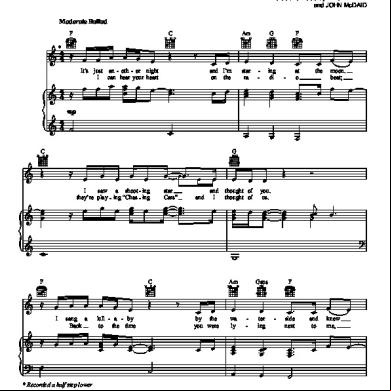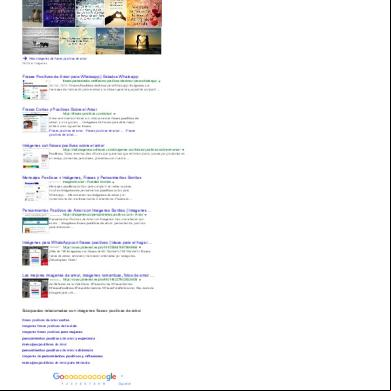Ease Examples 306f3e
This document was ed by and they confirmed that they have the permission to share it. If you are author or own the copyright of this book, please report to us by using this report form. Report 3i3n4
Overview 26281t
& View Ease Examples as PDF for free.
More details 6y5l6z
- Words: 1,960
- Pages: 12
EASE (Electro-Acoustic Simulator for Engineers) Check out EASE Website: http://ease.afmg.eu/
EASE is the industry-standard software that allows the creation of a 3-D acoustic model of any room and the simulation of a sound system in that room. First the room data is entered. This includes all 3-D points that reference surfaces in the room. Then data for the acoustic absorption of the materials that are on the walls and other surfaces are added to the model. From this data, reverberation times and other acoustic parameters can be calculated. These results are then used to test various modifications that might be made to improve the acoustics. Next, the fun begins. Loudspeakers are added to the model at locations consistent with the system design. Data for the 3-D frequency response is provided by loudspeaker manufacturers, and is part of the EASE database. Then, using the power of the computer, a complex impulse response is created from any loudspeaker or system of loudspeakers to any point in the room. This information can be expanded to allow the designers to evaluate all areas of importance. The designers then study the uniformity of distribution of sound over the listening area, as well as how much sound returns to the stage. And since the acoustics of the space have been computed, predictions of speech intelligibility can be mapped as well. All this can be accomplished before any money is spent on equipment, which may or may not provide the desired solution. A fraction of the money spent on the wrong solution can easily pay the fees of the professional design team, and save months of grief.
1
Some of the Power of EASE: Revealed
This is the beginning of a design using EASE. One builds a virtual room in the computer, entering geometrical data for the room point by point, then connect the dots. When complete, the virtual room is a wire frame drawing. Then every surface is defined in the computer. The computer needs to know what is on the surface and whether or not it is an audience/listening area. Once the data entry is complete, the computer with EASE software is used to perform complex audio calculations.
After completing the creation of the building in the computer, one can to run complex computations like the color-coded SPL map shown above. In the previous system, the sound engineers could not hear the speakers directly, which made their job nearly impossible. With EASE software, detailed 3-D full-room acoustic simulation including details of loudspeaker enclosures, their acoustical properties, detailed driver properties can be accurately simulated. WAV-format sound files can be loaded and “heard” in the virtual room, at any location! 2
One important calculation EASE does is predicting maximum SPL (Sound Pressure Level). This image predicts the level to be between 98 and 103 dB at 1000 Hz. This would equate out to a system capable of 111 dB. Yes, 111 dB is really loud but since we would like to see no less than 6 dB and preferably 10 dB of dynamic headroom, this design satisfies that need, without paying for more acoustic output than necessary.
The above figure shows a simulation of a church where three different acoustic treatment scenarios needed to be evaluated. EASE allowed sound engineers to check and compare the results of all three solutions in any combination. This enabled the customer make a cost to benefit judgment before spending any money.
3
The above figure shows a prediction of the total SPL (sound pressure level) map of the room with the chosen acoustic treatment installed. Note the smooth and even coverage of the system. Without EASE all anyone could do is spend a lot of money and hope they made a good guess.
The above figure shows another example, that of rehabilitating an old manufacturing space into a new space for use as a church. Again, acoustic engineers started by building the room in the computer. EASE enabled the acoustic engineers to recommend, with certainty, because of the low height to length ratio, that a time delayed distributed sound system was the only way to provide proper and even coverage for the entire room. The standard single cluster at the front, proposed by the contractor would not have worked. EASE kept the client from spending thousands of dollars on a solution that would not work.
4
When using time-delayed speakers, as in this building, alignment of first arrivals from all the speakers is critical to maintain localization. The even flow of color indicates that the timing of the system is correct.
The above figure shows another view of the first arrivals as viewed from within the listening area. The power of EASE enables viewing the same data from many vantage points.
5
The above figure shows a color-coded contour map of the arrival time gap between the first and the second pulse in milliseconds. In other words, this figure shows the arrival time differential between the first of two adjacent sources. This is another way of looking at a sound systems predicted performance before any equipment is purchased. This same calculation in another design would help in the decision to utilize a stereo system.
6
Another Example – Speech Intelligibility Problems in a Church:
The above figure shows the beginning of another design using EASE. In this case, a church with traditional acoustical needs for their church services had a problem associated with the intelligibility of Pastor’s voice, because older of the church congregation were experiencing difficulty hearing/understanding the Pastor with the church’s existing sound system. The problem needed to be solved, and like most churches, it needed to be solved on a limited budget. The installation of a conventional cluster speaker was unacceptable because of the aesthetic impact. Further adding to the design challenge, the room was also very reverberant, and what ever design was used, it was critical to keep acoustic energy away from everywhere but the congregation. EASE provided the tools for the acoustical engineers to find a solution that was within the budget of the church.
7
The above figure shows the solution. By using eight small, but very high quality speakers, mounted to, and partially hidden by the overhead beams, acoustical engineers were able to achieve excellent direct coverage of the congregation, putting very little acoustic energy on the walls. The red area is where the majority of the acoustic energy was directed, and as you can see, very little reached the walls.
8
This church also wanted the acoustic engineering firm to design a sound system using as few speakers as possible. The major concern was that destructive interference is a common problem between widely-dispersed speakers. Using EASE the acoustic engineers could see that the only massive interference area (The red in the drawing) was right down the middle of the main aisle. So there was no problem in this regard, and the issue was able to be quantitatively understood before the new sound system was installed.
Once in a while a customer will want to know what their building will look like after the new system is installed. If there is no architect providing these types of rendered drawings, EASE can also create images, like the above, to help visualize the results.
9
The above figure shows a computer rendering of the suspension system and method of attachment for one of the speakers. Omitted from the drawing is the ceiling that hides everything except the speaker and its yoke. that the things one doesn't see are just as important as the things one does see.
EASE is capable of extreme detail, as exemplified in the above figure. This helps the customer understand the existing problems and the solutions to these problems provided by acoustical engineers. Even though EASE has tremendous power, it is just a tool. A powerful software tool such as EASE in the hands of an experienced acoustic engineer can produce acoustical works of art!
A Solution Aided by EASE: Identified with Talent This church had a sound system that was installed without the help of professional sound engineers. After it was installed many of the congregation complained about not being able to understand what was being said. This was disappointing, especially after spending all that money. In desperation, the Church hired a contractor who came in and made minor aiming adjustments to the speakers: No help. Still another contractor said it just needed to be equalized correctly and everything would be fine. Wrong again. Using one’s best sound tools – one’s ears – the sound engineers listened to the church’s room acoustics and concluded that the room sounded very hot (reverberant). Before deg the new system they carried out %ALCONS predictions (Percent of Articulation Loss of CONSonants – see below) with EASE acoustic software, using both the existing room, and the room after some treatment options were analyzed. The sound engineers created a plan to install acoustic material in specific, but important, areas of the room at the same time the new sound system was being installed. The following image of %ALCONS graphically shows the results. The only difference in the two responses is the addition of acoustic treatment.
10
The above figure shows a color-coded %ALCONS contour map of the church with its original sound system and acoustic environment. The dark green areas is 5% ALCONS and the lighter green area is 6%. The yellow is 7%, and generally the maximum ALCONS that should be allowed. The light orange is 8% loss dark orange is 9% loss, and red is 10% loss. Thus, any area that is orange is marginal and no more than 10% of the seating should be orange. As one can see from the image, approximately 70% of the seats were unacceptable, in of %ALCONS!
The above figure shows what a difference the new sound system with acoustic treatment made to this room. Now the green areas occupy a much larger area and the yellow, which represents good, covers the balance of the seats. There is no orange or red to be seen. Everyone in the church congregation now hears with ease (no pun intended)!
11
%ALCONS: Please Explain Why I Should Care? Percentage Articulation Loss of Consonants is an indication of the loss of speech intelligibility that occurs in acoustic environments. For years, the acceptable maximum design %ALCONS was 15%, and was based on the requirement to have at least 25 dB of signal to noise ratio, and uniform frequency response in the 2-4 KHz spectrum, which is the critical speech intelligibility spectrum. In the past few years, the study of speech intelligibility has led the sound industry to find 10% a more appropriate maximum for most purposes. When the information being delivered is familiar or expected, 10% is marginally acceptable. In a learning environment, especially for people with hearing impairment, the target %ALCONS should be closer to 5%. Life Safety and Voice Warning Systems have similar stringent requirements for high speech intelligibility, as they are required to deliver instructions and information that may literally be a matter of life and death. If you're involved in any project with critical sound system requirements, you should have the acoustical environment and the loudspeaker system designed by an acoustical consultant. For most church sound systems, experience has shown that the %ALCONS should be between 4% and 7%. Less than 4% and the system will have a cold and sterile sound. Above 7% and the distinction in the sound is lost. Highly reverberant levels can add to %ALCONS, but eliminate too much reverb and one will loose musicality and warmth. Deciding on what levels of %ALCONS are acceptable is a semi-quantitative judgment, one which should only be made by highly experienced, professional acoustical engineers.
12
EASE is the industry-standard software that allows the creation of a 3-D acoustic model of any room and the simulation of a sound system in that room. First the room data is entered. This includes all 3-D points that reference surfaces in the room. Then data for the acoustic absorption of the materials that are on the walls and other surfaces are added to the model. From this data, reverberation times and other acoustic parameters can be calculated. These results are then used to test various modifications that might be made to improve the acoustics. Next, the fun begins. Loudspeakers are added to the model at locations consistent with the system design. Data for the 3-D frequency response is provided by loudspeaker manufacturers, and is part of the EASE database. Then, using the power of the computer, a complex impulse response is created from any loudspeaker or system of loudspeakers to any point in the room. This information can be expanded to allow the designers to evaluate all areas of importance. The designers then study the uniformity of distribution of sound over the listening area, as well as how much sound returns to the stage. And since the acoustics of the space have been computed, predictions of speech intelligibility can be mapped as well. All this can be accomplished before any money is spent on equipment, which may or may not provide the desired solution. A fraction of the money spent on the wrong solution can easily pay the fees of the professional design team, and save months of grief.
1
Some of the Power of EASE: Revealed
This is the beginning of a design using EASE. One builds a virtual room in the computer, entering geometrical data for the room point by point, then connect the dots. When complete, the virtual room is a wire frame drawing. Then every surface is defined in the computer. The computer needs to know what is on the surface and whether or not it is an audience/listening area. Once the data entry is complete, the computer with EASE software is used to perform complex audio calculations.
After completing the creation of the building in the computer, one can to run complex computations like the color-coded SPL map shown above. In the previous system, the sound engineers could not hear the speakers directly, which made their job nearly impossible. With EASE software, detailed 3-D full-room acoustic simulation including details of loudspeaker enclosures, their acoustical properties, detailed driver properties can be accurately simulated. WAV-format sound files can be loaded and “heard” in the virtual room, at any location! 2
One important calculation EASE does is predicting maximum SPL (Sound Pressure Level). This image predicts the level to be between 98 and 103 dB at 1000 Hz. This would equate out to a system capable of 111 dB. Yes, 111 dB is really loud but since we would like to see no less than 6 dB and preferably 10 dB of dynamic headroom, this design satisfies that need, without paying for more acoustic output than necessary.
The above figure shows a simulation of a church where three different acoustic treatment scenarios needed to be evaluated. EASE allowed sound engineers to check and compare the results of all three solutions in any combination. This enabled the customer make a cost to benefit judgment before spending any money.
3
The above figure shows a prediction of the total SPL (sound pressure level) map of the room with the chosen acoustic treatment installed. Note the smooth and even coverage of the system. Without EASE all anyone could do is spend a lot of money and hope they made a good guess.
The above figure shows another example, that of rehabilitating an old manufacturing space into a new space for use as a church. Again, acoustic engineers started by building the room in the computer. EASE enabled the acoustic engineers to recommend, with certainty, because of the low height to length ratio, that a time delayed distributed sound system was the only way to provide proper and even coverage for the entire room. The standard single cluster at the front, proposed by the contractor would not have worked. EASE kept the client from spending thousands of dollars on a solution that would not work.
4
When using time-delayed speakers, as in this building, alignment of first arrivals from all the speakers is critical to maintain localization. The even flow of color indicates that the timing of the system is correct.
The above figure shows another view of the first arrivals as viewed from within the listening area. The power of EASE enables viewing the same data from many vantage points.
5
The above figure shows a color-coded contour map of the arrival time gap between the first and the second pulse in milliseconds. In other words, this figure shows the arrival time differential between the first of two adjacent sources. This is another way of looking at a sound systems predicted performance before any equipment is purchased. This same calculation in another design would help in the decision to utilize a stereo system.
6
Another Example – Speech Intelligibility Problems in a Church:
The above figure shows the beginning of another design using EASE. In this case, a church with traditional acoustical needs for their church services had a problem associated with the intelligibility of Pastor’s voice, because older of the church congregation were experiencing difficulty hearing/understanding the Pastor with the church’s existing sound system. The problem needed to be solved, and like most churches, it needed to be solved on a limited budget. The installation of a conventional cluster speaker was unacceptable because of the aesthetic impact. Further adding to the design challenge, the room was also very reverberant, and what ever design was used, it was critical to keep acoustic energy away from everywhere but the congregation. EASE provided the tools for the acoustical engineers to find a solution that was within the budget of the church.
7
The above figure shows the solution. By using eight small, but very high quality speakers, mounted to, and partially hidden by the overhead beams, acoustical engineers were able to achieve excellent direct coverage of the congregation, putting very little acoustic energy on the walls. The red area is where the majority of the acoustic energy was directed, and as you can see, very little reached the walls.
8
This church also wanted the acoustic engineering firm to design a sound system using as few speakers as possible. The major concern was that destructive interference is a common problem between widely-dispersed speakers. Using EASE the acoustic engineers could see that the only massive interference area (The red in the drawing) was right down the middle of the main aisle. So there was no problem in this regard, and the issue was able to be quantitatively understood before the new sound system was installed.
Once in a while a customer will want to know what their building will look like after the new system is installed. If there is no architect providing these types of rendered drawings, EASE can also create images, like the above, to help visualize the results.
9
The above figure shows a computer rendering of the suspension system and method of attachment for one of the speakers. Omitted from the drawing is the ceiling that hides everything except the speaker and its yoke. that the things one doesn't see are just as important as the things one does see.
EASE is capable of extreme detail, as exemplified in the above figure. This helps the customer understand the existing problems and the solutions to these problems provided by acoustical engineers. Even though EASE has tremendous power, it is just a tool. A powerful software tool such as EASE in the hands of an experienced acoustic engineer can produce acoustical works of art!
A Solution Aided by EASE: Identified with Talent This church had a sound system that was installed without the help of professional sound engineers. After it was installed many of the congregation complained about not being able to understand what was being said. This was disappointing, especially after spending all that money. In desperation, the Church hired a contractor who came in and made minor aiming adjustments to the speakers: No help. Still another contractor said it just needed to be equalized correctly and everything would be fine. Wrong again. Using one’s best sound tools – one’s ears – the sound engineers listened to the church’s room acoustics and concluded that the room sounded very hot (reverberant). Before deg the new system they carried out %ALCONS predictions (Percent of Articulation Loss of CONSonants – see below) with EASE acoustic software, using both the existing room, and the room after some treatment options were analyzed. The sound engineers created a plan to install acoustic material in specific, but important, areas of the room at the same time the new sound system was being installed. The following image of %ALCONS graphically shows the results. The only difference in the two responses is the addition of acoustic treatment.
10
The above figure shows a color-coded %ALCONS contour map of the church with its original sound system and acoustic environment. The dark green areas is 5% ALCONS and the lighter green area is 6%. The yellow is 7%, and generally the maximum ALCONS that should be allowed. The light orange is 8% loss dark orange is 9% loss, and red is 10% loss. Thus, any area that is orange is marginal and no more than 10% of the seating should be orange. As one can see from the image, approximately 70% of the seats were unacceptable, in of %ALCONS!
The above figure shows what a difference the new sound system with acoustic treatment made to this room. Now the green areas occupy a much larger area and the yellow, which represents good, covers the balance of the seats. There is no orange or red to be seen. Everyone in the church congregation now hears with ease (no pun intended)!
11
%ALCONS: Please Explain Why I Should Care? Percentage Articulation Loss of Consonants is an indication of the loss of speech intelligibility that occurs in acoustic environments. For years, the acceptable maximum design %ALCONS was 15%, and was based on the requirement to have at least 25 dB of signal to noise ratio, and uniform frequency response in the 2-4 KHz spectrum, which is the critical speech intelligibility spectrum. In the past few years, the study of speech intelligibility has led the sound industry to find 10% a more appropriate maximum for most purposes. When the information being delivered is familiar or expected, 10% is marginally acceptable. In a learning environment, especially for people with hearing impairment, the target %ALCONS should be closer to 5%. Life Safety and Voice Warning Systems have similar stringent requirements for high speech intelligibility, as they are required to deliver instructions and information that may literally be a matter of life and death. If you're involved in any project with critical sound system requirements, you should have the acoustical environment and the loudspeaker system designed by an acoustical consultant. For most church sound systems, experience has shown that the %ALCONS should be between 4% and 7%. Less than 4% and the system will have a cold and sterile sound. Above 7% and the distinction in the sound is lost. Highly reverberant levels can add to %ALCONS, but eliminate too much reverb and one will loose musicality and warmth. Deciding on what levels of %ALCONS are acceptable is a semi-quantitative judgment, one which should only be made by highly experienced, professional acoustical engineers.
12










